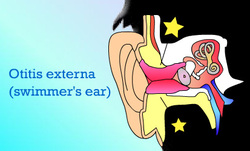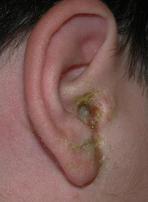What is otitis media?
There are four different types of otitis media, with 'Glue Ear' being the most commonly mis or undiagnosed.
Glue ear listed as number four "4" on this page
You may find the hearing loss checklist at the bottom of the page handy, and it is printable.

A NORMAL eardrum.
NO infection or fluid in the middle ear is present.
You can see the reflection of the doctor's ear torch shining back at you.
Symptoms of acute otitis media (ear infection):
- Fever and or headaches
- Head cold/ flu
- May have frequent colds and runny nose.
- Sore, red or runny ears (although often children who have had constant ear problems, from a toddler, become immune to the pain as they think it is normal, so often wont complain)
2. Chronic suppurative otitis media

Refers to the presence of a hole in the eardrum with continuing discharge of pus from the middle ear over many weeks.
If left un-treated this hole will not close itself naturally. It will need to be surgically repaired - which can be a painful operation. These surgeries are normally left until after the age of 8 years when the eustachian tube has matured,
If left un-treated this hole will not close itself naturally. It will need to be surgically repaired - which can be a painful operation. These surgeries are normally left until after the age of 8 years when the eustachian tube has matured,
Symptoms of chronic suppurative otitis media:
- Constant ear pus draining from the ear canal. The child needs medical attention from a G.P
- If this pus has an odor, it may have a severe infection and needs urgent medical treatment.
- If this pus has an odor, it may have a severe infection and needs urgent medical treatment.
3. Otitis media externa
This type of infection occurs in the ear canal and NOT the middle ear. It is also known as 'swimmers ear' and is more common in older children and adults. Water and bacteria entering the ear canal is a common cause.
It is also very common in Tradesmen as they use and re-use dirty ear plugs.
It is also very common in Tradesmen as they use and re-use dirty ear plugs.
Symptoms of otitis externa
- Itchy ear
- Painful, swollen ear canal
- Discharge
- Eczema around the opening of canal
- Painful, swollen ear canal
- Discharge
- Eczema around the opening of canal
4. Otitis media with effusion commonly known as GLUE EAR

Otitis media with effusion is a very common condition that occurs in children. Effusion is just another term for fluid.
The eardrum is not red or inflamed and there is no pain or fever.
Fluid in the middle ear can last many months.
It can also be there one week and gone the next, then return again.
This is why it is VERY HARD to diagnose.
This is why REGULAR hearing testing is so important. Some children take months to diagnose via hearing testing as the fluid may not be present at the time your child is tested. Go with your gut feeling and continue to have your child's middle ear health checked if they are having problems with their speech, learning or behaviour. The checklist below will help you.
THE EARDRUM WILL NOT VIBRATE NORMALLY WHEN A CHILD HAS FLUID IN THE MIDDLE EAR.
*Your GP may diagnose glue ear but then it may not be present at the time of the hearing testing, so make sure you book in for another hearing test in 3-4 months. Each time you visit the Dr ask to have your child's ears checked- even if you are there for something un-related to otitis media.
If your child does not have testing at their school, why not try to make each school holidays your time to have your children's hearing tested.
The eardrum is not red or inflamed and there is no pain or fever.
Fluid in the middle ear can last many months.
It can also be there one week and gone the next, then return again.
This is why it is VERY HARD to diagnose.
This is why REGULAR hearing testing is so important. Some children take months to diagnose via hearing testing as the fluid may not be present at the time your child is tested. Go with your gut feeling and continue to have your child's middle ear health checked if they are having problems with their speech, learning or behaviour. The checklist below will help you.
THE EARDRUM WILL NOT VIBRATE NORMALLY WHEN A CHILD HAS FLUID IN THE MIDDLE EAR.
*Your GP may diagnose glue ear but then it may not be present at the time of the hearing testing, so make sure you book in for another hearing test in 3-4 months. Each time you visit the Dr ask to have your child's ears checked- even if you are there for something un-related to otitis media.
If your child does not have testing at their school, why not try to make each school holidays your time to have your children's hearing tested.
How do you know if your child may have otitis media?
Below is a checklist we use in schools developed by the Department of Education Hearing Support Team in Dubbo. It helps to identify possible hearing problems. Please share it with your friends.
***Take notice on the checklist in the 'Behaviour Identifiers' table
- the similarities hearing loss has to ADHD/Autism!
| parent_hoh_hearing_loss_checklist_2020.pdf |



